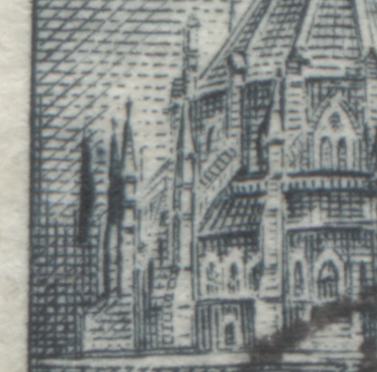Brixton Chrome
Lot 222 Canada #544iv 8c Slate Queen Elizabeth II, 1967-1973 Centennial Issue, A Very Fine Used Block Of 4 On LF Smooth Paper, Extra Spire Variety
Lot 222 Canada #544iv 8c Slate Queen Elizabeth II, 1967-1973 Centennial Issue, A Very Fine Used Block Of 4 On LF Smooth Paper, Extra Spire Variety
A very fine used block of 4 of the 8c slate Queen Elizabeth II from the 1967-1973 Centennial Issue on LF smooth paper, extra spire variety.
Unitrade values this at $100. The block offered here grades 75 as follows:
Centering/Margins: 35/60
Paper Freshness: 5/5
Colour: 5/5
Impression: 5/5
Absence of Visible Paper Flaws: 5/5
Perforations: 10/10
Cancellation: 10/10
There are several important points to keep in mind when reading the lot descriptions for the Centennial issue stamps:
1. Nearly all of the stamps except for the 6c black show variations in the shades that vary from extremely subtle to quite obvious. None of these variations are listed. In additon to those differences found in the shades in normal light, some of these inks show variations under UV light, where the colour changes under UV.
2. The papers as listed in Unitrade are generally quite simplified in relation to what actually exists. For starters, the colour of the paper under UV can vary from bluish white, to cream or ivory to deep blue or violet. The fluorescence as listed is often a combination of an ambient, or inherent fluorescence level, which is modified by the presence of fluorescent or wodpulp fibres. Fluorescent fibres raise the perceived fluorescence of the paper, and both the brightness and concentration of these fibres will vary considerably. A stamp can have LF, MF and HF fibres all at once, in the paper. Concentrations of fibres on this issue varies from very few, which is just one or 2 fibres on the whole stamp, to low density, where the fibres extend across the whole stamp, but where some 1-2 mm spaces between fibre clusters are visible. Within this range there are sparse and very sparse concentrations, the difference being in how large the spaces are between fibre clusters. Woodpulp fibres have the effect of dampening the perceived fluorescence, and appear as brownish flecks in the paper.
3. The Dex gum varies in terms of its sheen, with smooth semi-gloss, streaky semi-gloss, smooth satin and streaky satin sheens being found. Unless otherwise described, the default sheen is semi-gloss. Two types of PVA gum can be found: satin and eggshell. Satin gum has a clear smooth, white appearance and it is clear that gum is present. Eggshell on the other hand is thinner and shows the rough texture of the paper more, so that it is not so obvious that gum is present.
4. The paper can be either horizontal or vertical wove, and this is determined by seeing which way the paper flexes most easily. Horizontal wove flexes easily from top to bottom, whereas the opposite is true for vertical wove.
5. Both smooth and vertical ribbed papers can be found. This is particularly true of the high values and is especially noticeable in used stamps, as there is no gum. However, even on mint stamps the ribbing can usually be seen in the gum. Again none of the specialized catalogues that we are aware of list these varieties.
6. The perforations vary considerably. CBN used at least four machines that gauge 11.85, 11.95, 11.9, 12 and 12.1, so that stamps can have any compound of these measurements. That being said, by 1971-1972 the most common measurement is 11.85, as this machine replaced the machines giving the earlier 12 and 11.9 gauges. Generally speaking we have not checked the perforations due to time constraints. Consequently the lot could be any one of the many perforations found within this range. If you want us to check a particular meaurement, please ask and we will oblige.
7. The Winnipeg tagging varies in colour under UV from a bluish white glow to a greenish yellow. Also, the strength of the bands visible on the stamps varies from almost invisible to dark yellow.
Share




